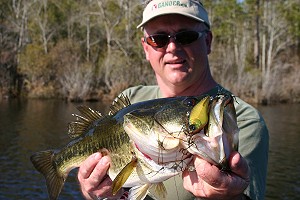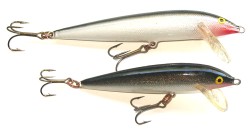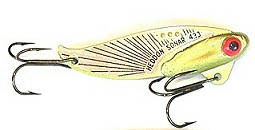|
As much print as crankbaits have commanded in articles, books, and other publications, very little material has been devoted to the sinking “count-down” style crankbait. In fact, few anglers own or even know how to effectively use these highly efficient deep water tools. Without the proper working knowledge of sinking count-down lures, and what their true functions are, any typical sinking crankbait does nothing more than collect weeds or occupy space in your tacklebox. While floating divers and suspender crankbaits continue to get all the press and playing time, sinking “count-down” cranks wait in the wings for a chance to prove. They are the true dark horses of the crankbait world.
Sinking count-down crankbaits are very specialized tools very comparable to a metric ratchet set.While they do have multiple uses, they’re primarily designed for clean bottom and open water use. Whenever fish are hugging the bottom in deeper waters, this style of crankbait is likely to catch more fish than any other. Whenever fish are suspended over deep open water, this style of crankbait is likely to catch more fish than any other. In other words, they get deep, and to fish that other lures simply can’t reach.
Generally, sinking count-downs are poor choices for any cover laden conditions, although the sinking lipless crankbait, which can be classified as a sinking count-down, works quite well over such cover. On average however, sinking crankbaits are more apt to get hung up in cover. When that cover is woody, you’re probably going to loose a few baits now and then. More often a sinking cranker is best used over clean bottoms and suspended big gamefish holding at depths below levels reachable with conventional crankbaits. The key is to have a few of these sinkers available, and then try them in these specific situations.
The perfect depth level for a sinking crankbait begins somewhere around twelve (12) feet. Not surprisingly, this is the basic cut-off depth where traditional floating/diving crankbaits and their suspending cousins level off in productivity. On a conventional cast few floating divers nor suspending crankers attain depths greater than twelve feet with any regularity.However, the sinking crankbait reaches this depth level and greater with no problem at all.
The simple secret lies in its ability to sink. Instead of trying to grind a floating diver down to the twelve foot level with a long cast, fast retrieve and lighter gauge line, all one has to do with a sinking count-down is cast it out and let it sink to that level. Basically, it will get there on its own. Because this lure sinks, it can reach virtually any level desired. It can be fished tightly to the bottom in real deep waters, as well as worked at various levels over open areas in search of suspended fish. Because the lure has no buoyancy, it will not rise upward when retrieved. In fact, slower retrieve speeds may actually make the lure run a bit deeper.
DOCUMENT THE “SINK RATE”
One of the basic fundamentals with any sinking crankbait is to document how fast the lure sinks, or what I like to call the “sink rate”. This is essential if you hope to get the lure down to any precise level for suspended fish. Without knowing the sink rate, precise depth control is not possible and you’ll rarely score big on suspended fish.You must take the time and steps to record how fast your lure sinks. This is why I like to call these lures “count-downs”. Because you need to count-down as the lure sinks.
This whole process is actually quite easy to determine. You can do it on just one cast over the right spot. Simply position your boat over a known depth on a flat, cast the lure out and watch your line as you count the lure’s descent at a rate of “one — one thousand, two — one thousand, three –one thousand”, and so on. If the depth you’re at is 18 feet and the lure hits bottom at around a count of 18, you’ve got an easy formula for countdown crankin’. The bait has a “sink rate” of approximately one foot per second. This is the ideal sink rate, of course, since it makes it easy to tabulate how deep your lure is going without any math.
Yet, ideal sink rates of one-foot-per-second aren’t always possible. Some lures sink faster, while others descend slower.Having both fast sinkers and slow descenders is a good idea. You’ll find uses for both.I particularly like a slow sinker for many shallower situations in cold water. The key here is to have a lure that sinks, but is easy to keep control of it over shallower cover without the sinking nature of the lure overtaking its ability to perform. I prefer fast sinkers for all deep water situations. The deeper the water, the faster I want a count-down cranker to sink.Imagine how ineffective a slow sinking crankbait would be over lake trout holding down off a reef at 45 feet.If there’s any wind blowing, it’ll be double tough. That’s why you need both fast sinkers and slow descenders.
The sink rate of any crankbait will also be greatly effected by the line test you use. Just like floating/divers work deeper on thinner lines, count-downs generally sink faster on thinner lines, too. Thicker gauge lines create more drag making the lure sink a bit slower. The only way to know the sink rate of a particular lure on any given line gauge for sure is to test and record it. Usually, you’ll find an ideal line size that seems to perform best with your count-downs. For bass, I particularly like 10 pound test. For muskies, I’m partial to 30 pound plus. However, not that, if you prefer a heavier weight line that’s fine, too. Just remember to record that sink rate so you know what it is. Then, you’re off and running.
Sinking count-down crankbaits are exceptional on cold water fish since they enable the angler to retain depth at slow speeds. That’s why so many top flight cold water anglers use some form of a sinking lure in lower water temps. Depth retention at a slow retrieve speed is a critical element to cold water success. A typical floating crankbait needs speed to drive it down. A lack of speed usually pulls a buoyant cranker back up towards the surface. This is not so with a sinking crankbait.Slow retrieve speeds with a count-down keep the lure deep, and sometimes make it dive even deeper. This combination is often deadly on big fish resting along deep breaklines in the late fall.
One of my favorite places to cast count-downs is over deep cresting humps that top out way below the tracking range of any typical floating or suspending crankbait. Those humps that crest in that 14 to 22 foot range are typical of what I’m talking about here. Food shelves in this range get very little angling pressure. Even when they do, anglers are usually casting lures that run way above the tops of these humps. There’s no way you’re going to get a floating diver to reach this kind of depth level with any consistency, yet all you need to do to get a count-down to this depth is to simply cast it out, and let it sink all the way to the bottom. Then, by simply crankin’ at a slow to medium speed, you’ll have that count-down cranker bouncing at those 14 to 22 foot depths easily.
 |
I’ve also had great success utilizing a “rip and drop” technique with this bait on deep water areas. I begin the same way — casting the sinking cranker out and letting it sink all the way to the bottom.Then, instead of beginning a straight, steady retrieve, I rip forward on the lure with a sharp sideways or upward pull on the rod tip, followed by a “recovery pause” that allows the lure to sink back to the bottom while I reposition my rod for the next rip. This has been one of my deadliest deep water secrets for years on big muskies. It also works extremely well on deep water smallies.
For some reason, this retrieval method really ticks fish off, if they’re at all active. I’m talking about getting one of those much talked about “bone jarring strikes”. The “rip and drop” tactic triggers a violent response from monster muskies to belly-bustin’ bronzebacks. More often than not, the strike is so hard that the fish inhales the entire lure! I wouldn’t hesitate to predict that you will likely get more super strikes with this kind of crankin’ technique than with any other. You also nearly always get a great hookset since you’re basically initiating one everytime you rip the lure.
My biggest musky in the fall of 1993 hit in just this manner. I was diligently working on one of the first prototype designs of the Count-down DepthRaider series, and one clear October day, I picked the right spot to test it. It was a deep rock/gravel point that extended out beyond a large weedy bar, that was also part of the same point. My friends and I had seen a big musky on this spot several times throughout the season, but could never get it to hit. Whenever we saw it, it was always on the deep weed edge at the very tip of the point; right where the weeds met the rock and gravel. We hadn’t seen the fish in over a month, so we thought it had vacated the spot.
I just finished thoroughly casting the weed tops with various lures, and scouring the weed edge with a floating/diving crankbait, but did not see the big one, nor any other fish for that matter. However, deeper hard bottom adjacent to a good weed shelf should never be overlooked in the fall, and I already knew that this rock/gravel extension was a good one. I’d taken many muskies from this deeper finger in the past, as well as some nice strings of walleyes. It was the perfect place to USE the Count-Down DepthRaider.
Three casts into my count-down test told me I was onto something. I fired out a long bomb cast, somewhat perpendicular to the main body of the deep hard bottom projection, and let the big diver sink all the way down. As soon I hit a count of eighteen the line went slack indicating the lure had hit bottom. I immediately ripped forward on the rod tip hard, and let it sink back.Then I did it once more, but the lure didn’t sink back, so I ripped it forward again, only this time my rod tip buckled.What followed was kind of amazing. At first I thought I was hung up, but the snag kept moving. Eventually, I got that tell taled head shake at my rod tip, and I knew I was hooked into something big. The ensuing battle lasted over 10 minutes. This is astonishingly long for a musky fight on heavy tackle. The big fish stayed deep and fought extremely hard literally towing me around. When it finally surfaced, I was amazed to see both the size of the fish, a trophy of at least 52 inches, and no visible lure in its mouth. That’s right, the big musky had actually engulfed the entire nine inch crankbait and about three inches of the wire leader. Like I said, they really get ticked off when you “rip and drop” a count-down.
One of my biggest smallmouths this past spring was also taken with this “rip and drop” technique while filming one of my television episodes. I was fishing with guest, Mark Hesslemen representing Miller Friends Of The Field program, and we were casting lipless crankbaits for spring smallies off rock points and mid lake humps. It was a very windy day, which made it ideal for smallies to be active, riding high, and eager to chase down crankbaits.
Anyway, Mark and I were both casting various versions of a lipless crankbait including RatLTraps, Cordell Hotspots, and Luhr Jensen Sugar Shads. All of these baits were taking a few fish, but the Sugar Shad was particularly productive. As we crossed a large gravel point, Mark began casting the top of the bar for shallow cruisers, while I turned and fired a long bomb out off the very tip of the point and let the lipless cranker, a red craw Sugar Shad, sink all the way to the bottom. I then ripped up on my 71/2 foot crankin’ stick driving the Sugar Shad upward, followed by a pause allowing it to drop all the way back to the bottom. My intention was to check the deeper hard bottom hoping to find a bigger fish or two. It didn’t take long to find one!
The 2nd rip was met with an incredible strike, and an almost immediate missile as the big bronze back rocketed straight up from the depths breaking the surface with a big boil. As the camera rolled, I battled the 21 incher all the way to boatside and again was amazed to see the entire crankbait buried deep inside the fish’s mouth. It took quite an effort to get the lure out, and release this superb trophy unharmed. Like I said, big gamefish seem to get ticked off when you “rip and drop” a count-down sinking crankbait.
One of the very best weed flat walleye tactics I’ve ever come across lately involved utilizing one of the old classic Countdown Rapala lures. Actually I was tipped off to this technique by my friend Bruce Nimz, a northern Wisconsin game warden. Before that time I’d used this lure on occasion, and had caught some fish with it, but never to the extent that it became a choice bait. Then Bruce told me that he’d been really catching walleyes with a # 7 Countdown Rapala ripping it over cabbage weeds. Soon after Bruce told me about this tactic, I began really experimenting with the Countdown Rapala and the “rip & drop”. Successful outings since then have convinced me that the Countdown Rapala works a lot better with this retrieve than with any of the more conventional methods I’d been using.
What I realized from then on was that the relatively weak action of the Countdown Rapala at slow to medium retrieve speeds does little to trigger less active fish.That’s why you never really hear much about this lure as a fish catcher. Few anglers know how to utilize it properly. Heck, even the folks at Normark don’t promote the use of this technique with their lure. I’m now convinced that the rip & drop is the key technique with this bait. Start using the Countdown Rapala with a fast rip & drop technique and you’ll see it turn into a fish catchin’ dynamo.
 |
There are still a number of other crankbaits that sink, and all of them can be utilized with these various techniques discussed. Some of my favorite sinking crankbaits include the: RatLTrap, Sugar Shad, Cisco Kid, Count-down Rapala, Heddon Sonar, Luhr Jensen Rippletail, Countdown Rapala, and of course my big Count-down DepthRaider. All of these lures will catch deep water fish from muskies to bass to lake trout, utilizing the right tactics. The “rip and drop” tactic is especially effective with all of these lures. However, never discount a simple slow, straight retrieve either.
Metal blade baits, while not considered true crankbaits, really are a crankbait. I’m speaking of lures such as the Rippletail, Heddon Sonar, Silver Buddy, and Gay Blade.They work superbly well with the lift and drop technique. Some of the larger versions of this lure sink even faster than the desired one-foot-per-second making them outstanding choices for real deep water applications. They work particularly well on lake trout holding at depths greater than 50 feet. You can vertically jig these lures with equal efficiency, and that’s what most anglers use this lure for. But they can also be great casting baits for a host of deep water conditions. In particular, I’ve had outstanding success with the “rip and drop” technique on blade baits for lakers, walleyes, smallies, and northern pike. Southern bassers have done equally well on winter largemouths using the exact same method.
 |
Count-down, sinking crankbaits continue to be the overlooked player on the team. Even the most astute crankbait fishermen today neglect using this outstanding deep water tool. That, in itself, is the main focus of this lure — deep water. If you want to effectively fish depth ranges never before reachable with conventional crankbaits, start utilizing the count-down. Discipline yourself to fish these deeper areas slowly and thoroughly, taking full advantage of this lure’s capabilities. It won’t take long for you to build an unbreakable confidence in an entirely new bait category.Just remember what I said about those strikes on the “rip and drop” technique. They are truly “bone jarring”.
Hall of Fame angler Joe Bucher is the Editor Emeritus for Musky Hunter Magazine and one the most highly recognized multi-species fishing and hunting authorities in the outdoor business trade. Joe is the host of Fishing with Joe Bucher TV show which has been on the air for over 20 years. For more information on Joe please visit his website at JoeBucher.Com |